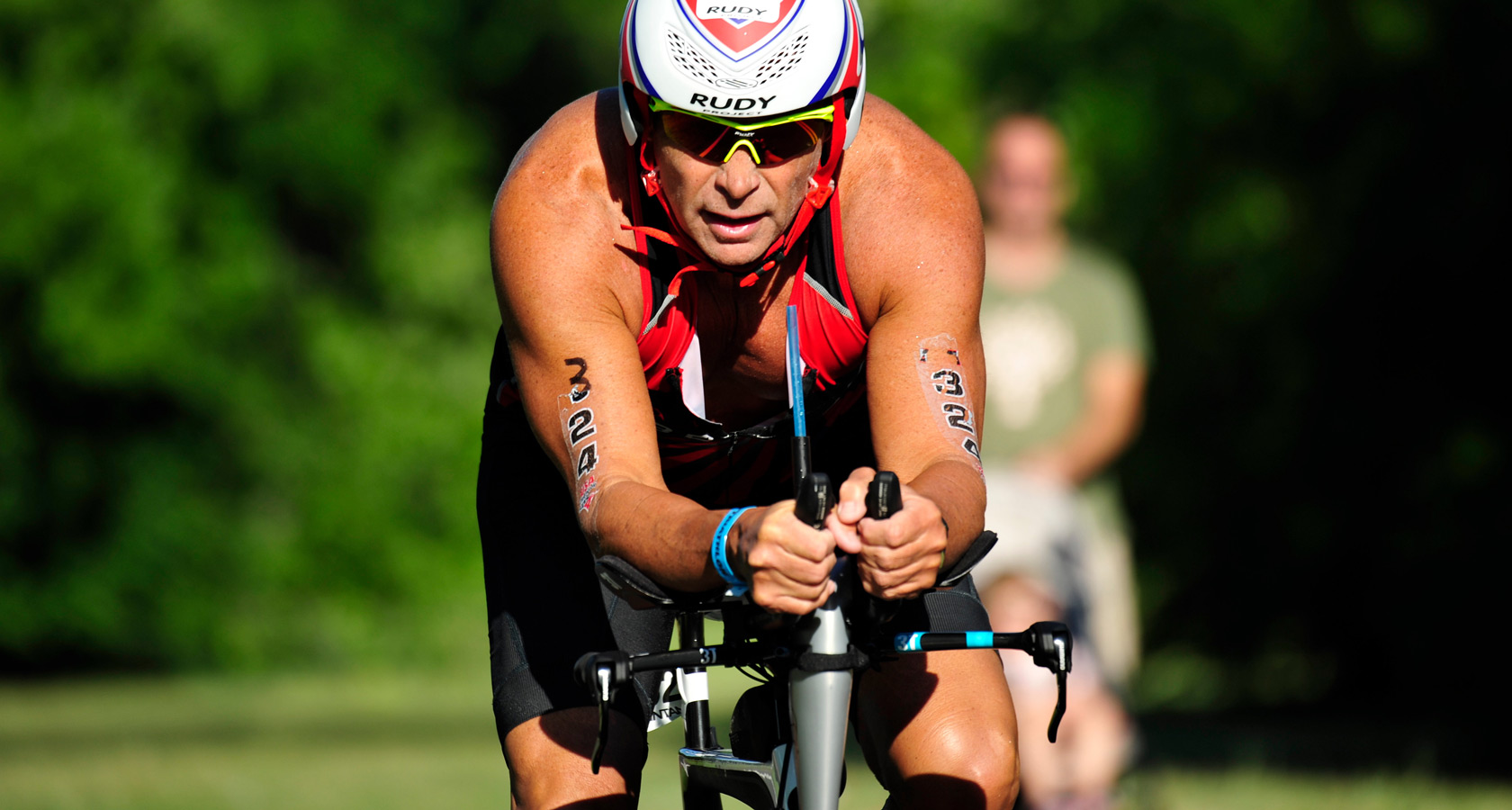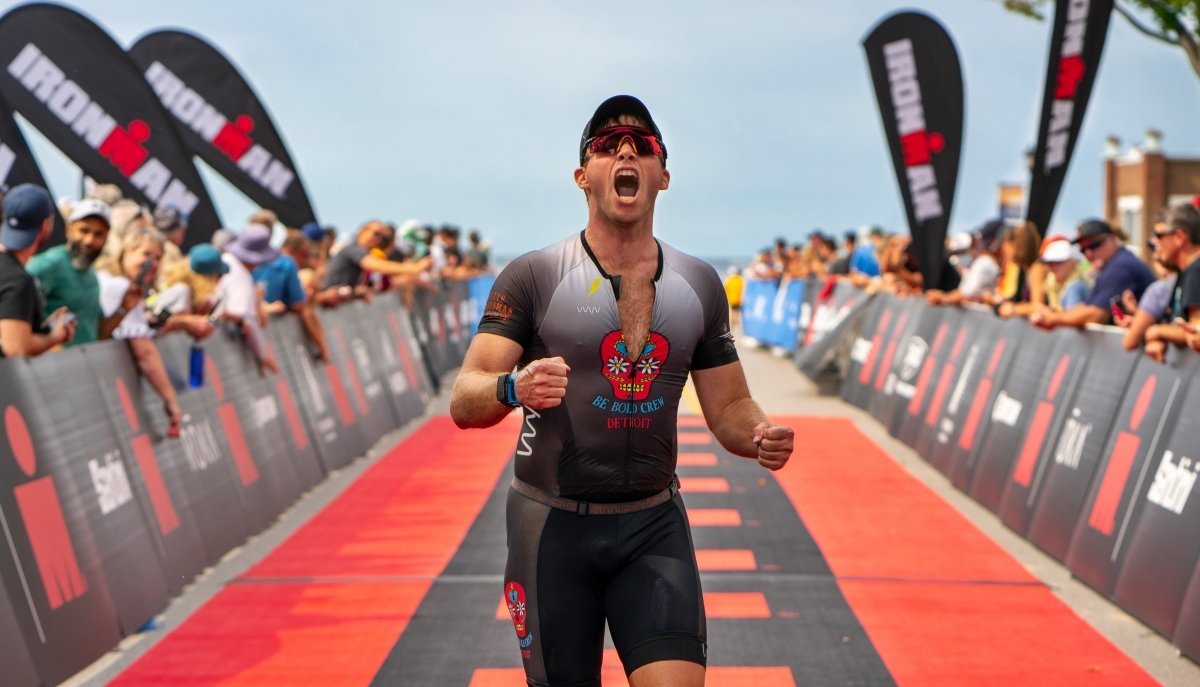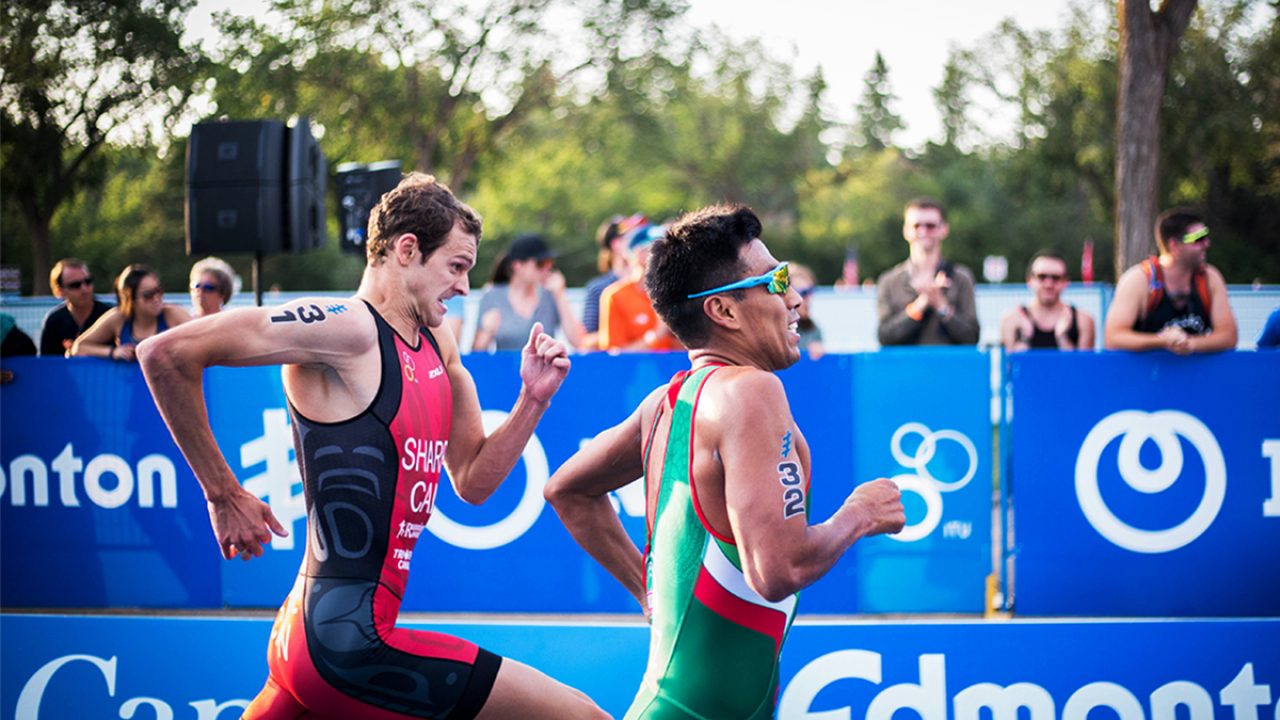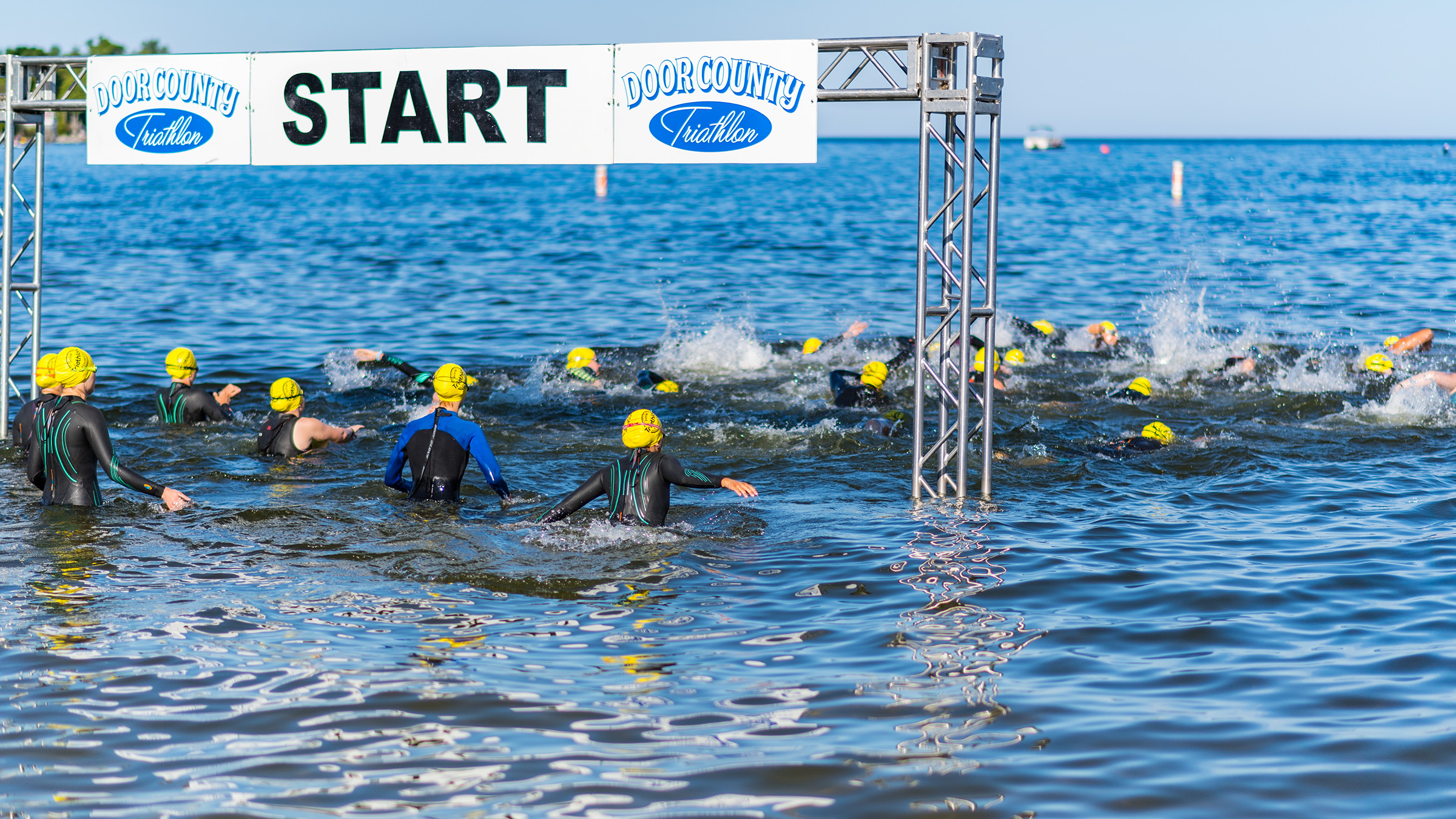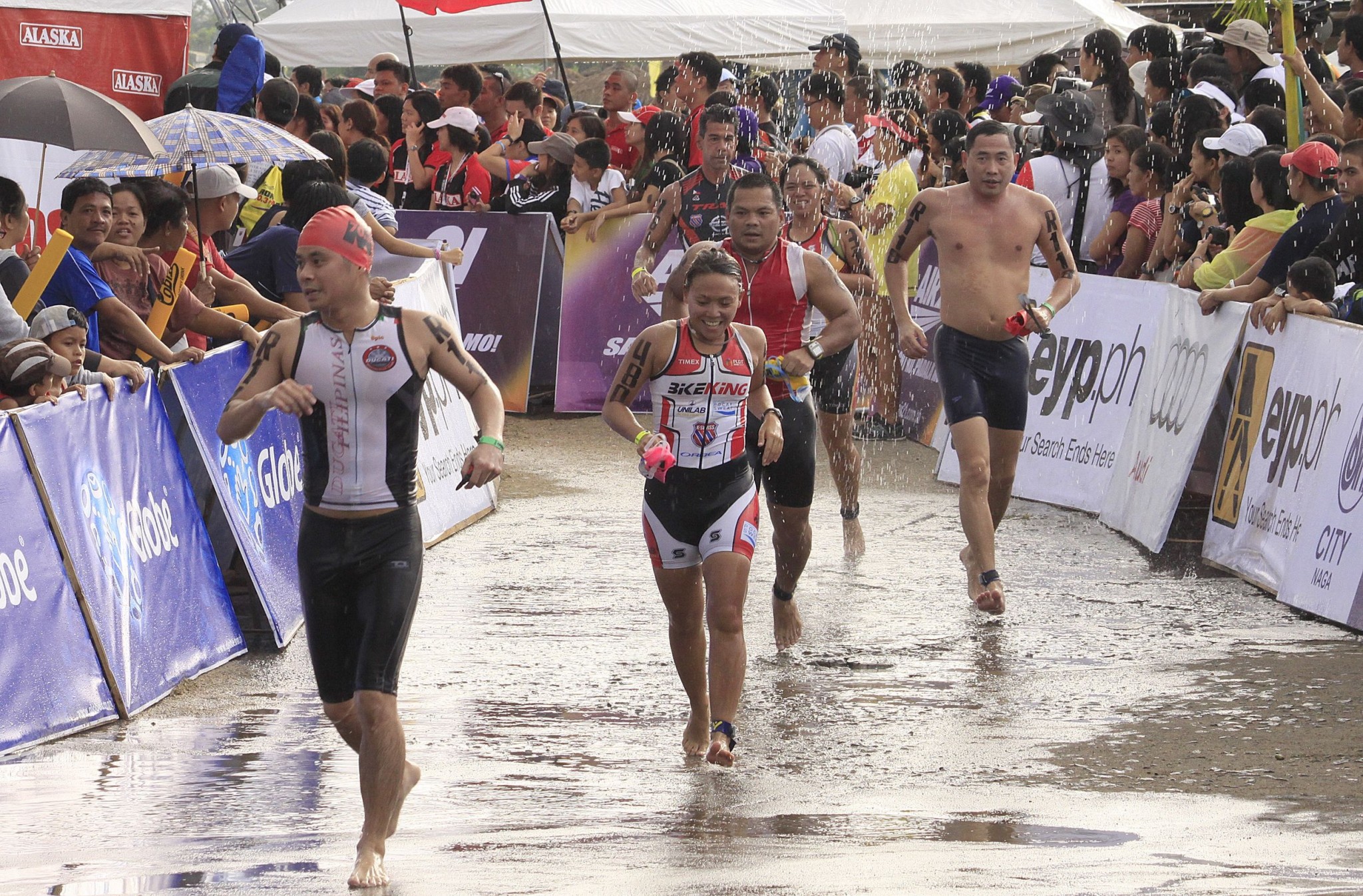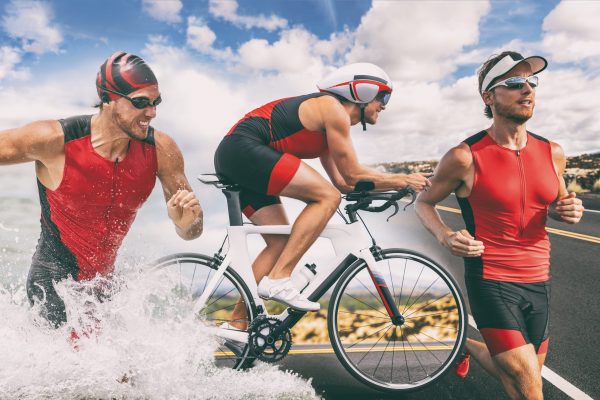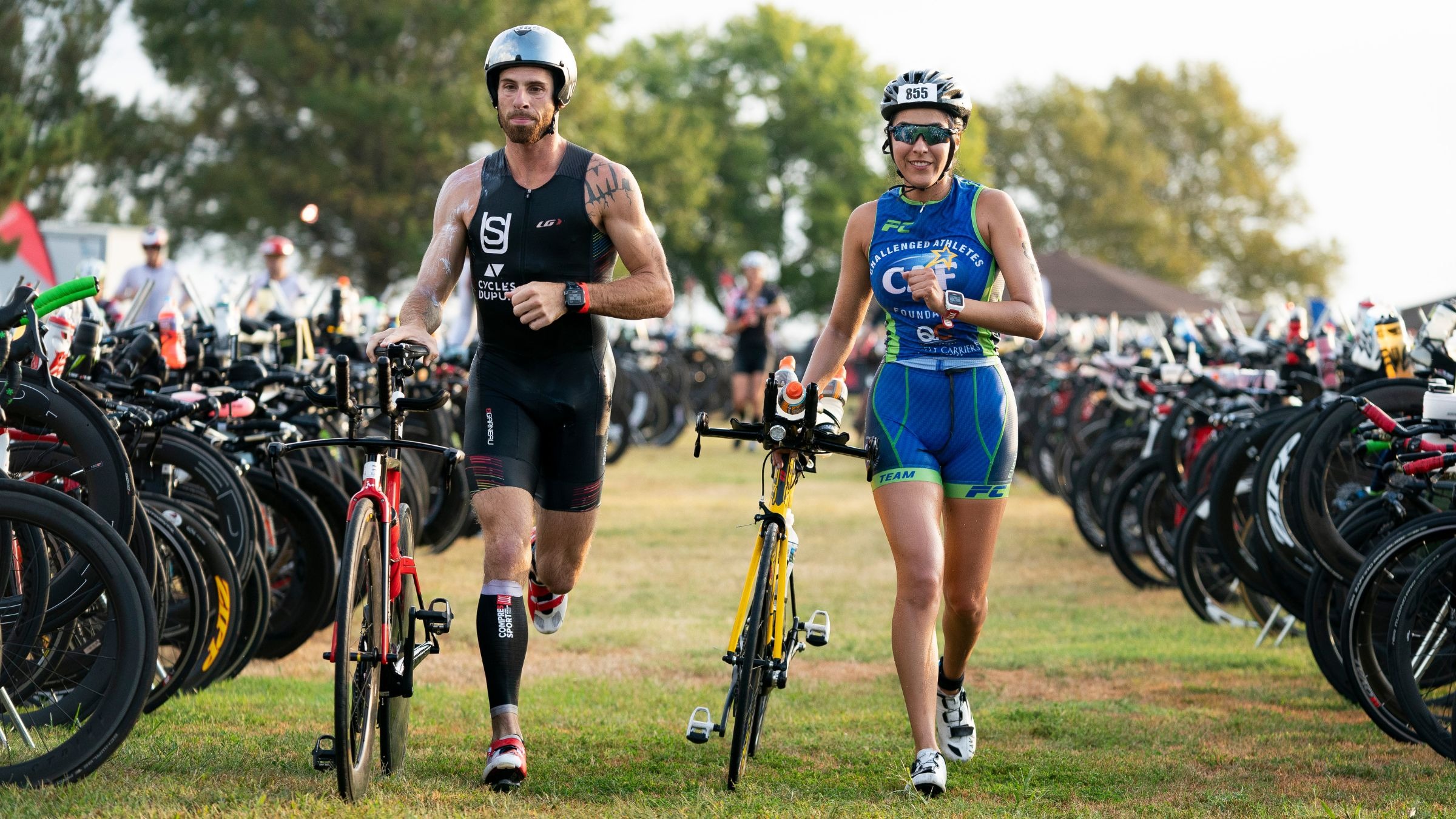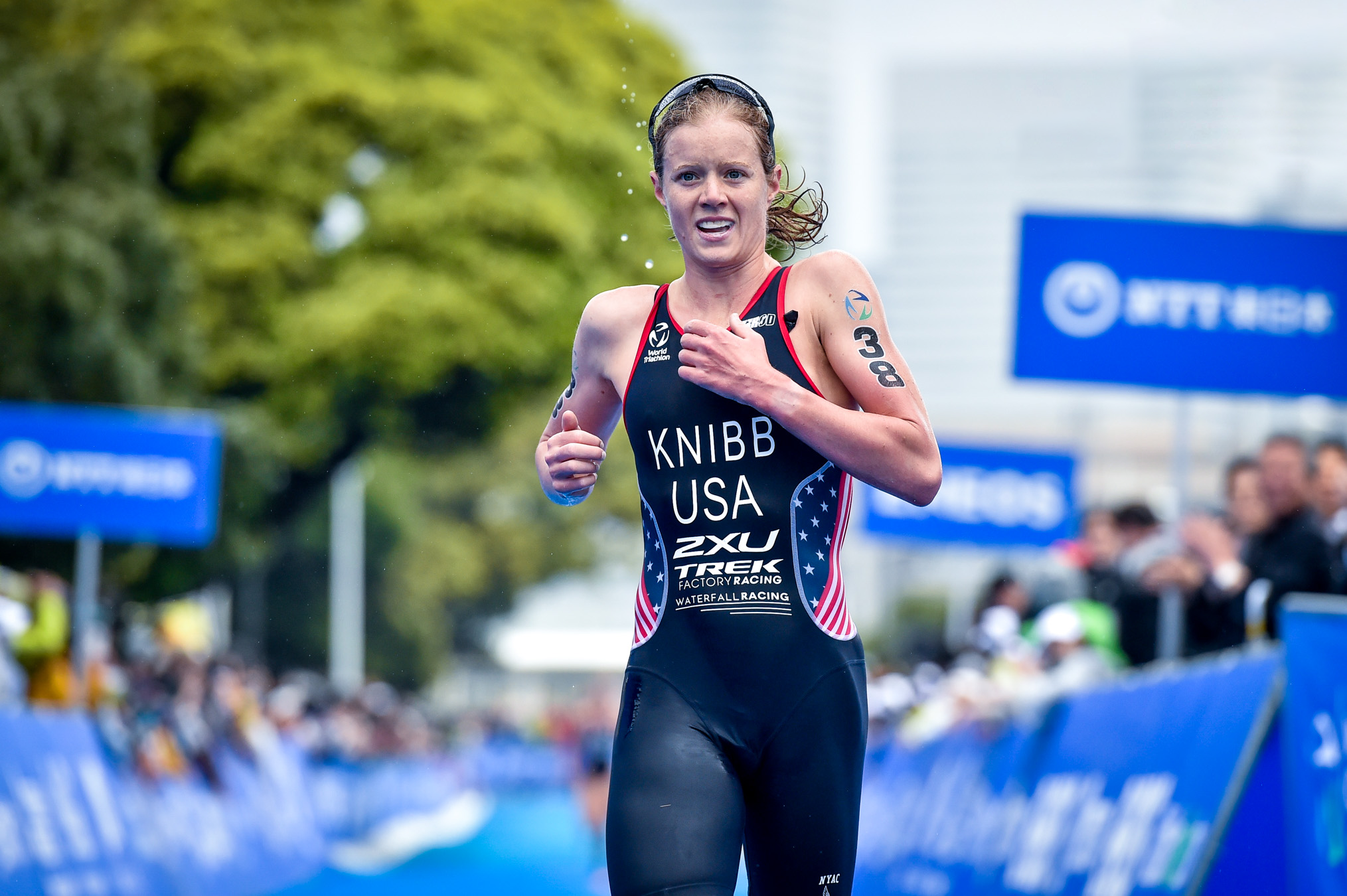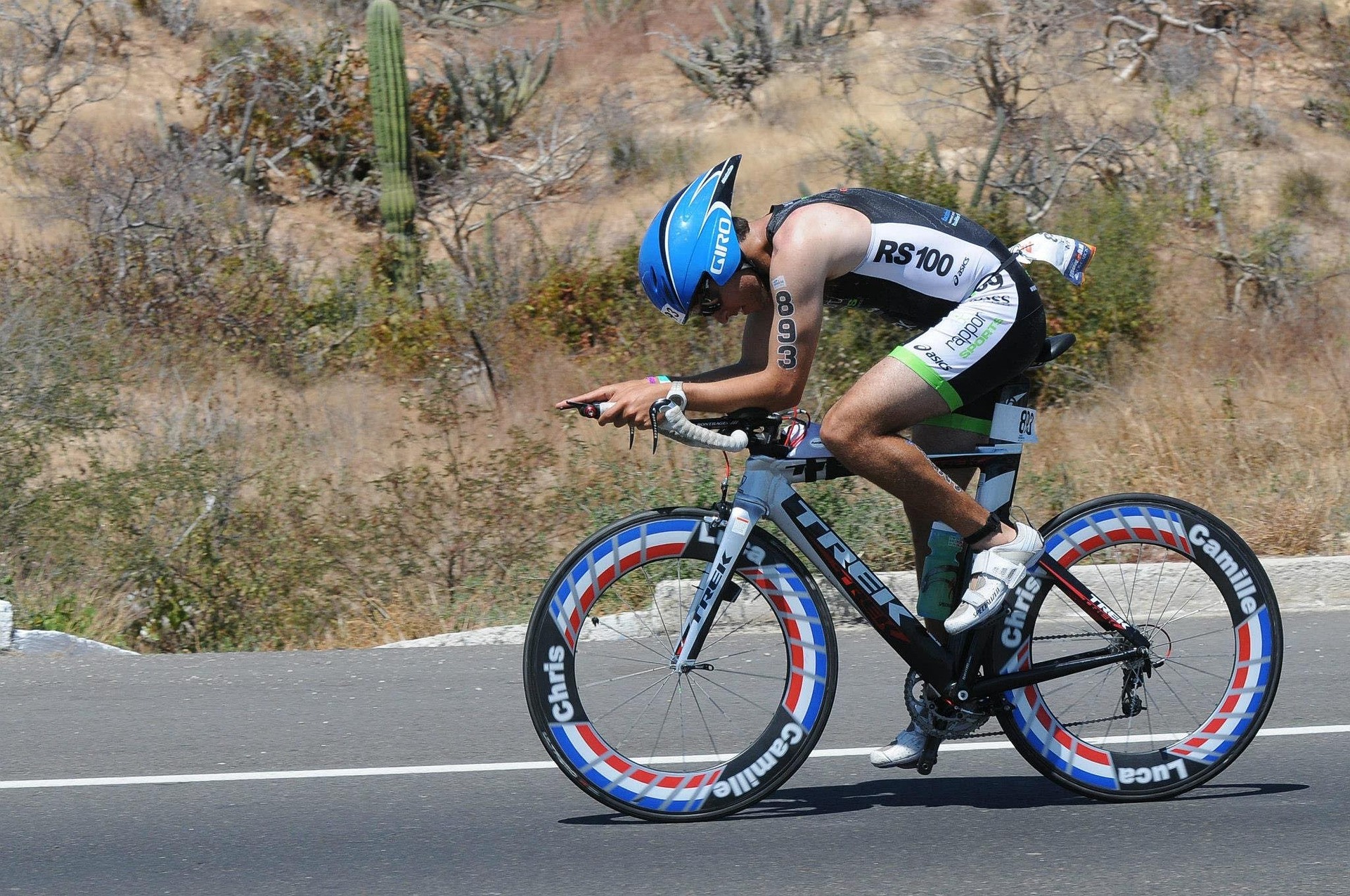

Featured
How To Train For Bike Race Triathlon
Modified: August 21, 2023
Looking to train for a bike race triathlon? Get featured tips and strategies to enhance your performance and prepare for an unforgettable racing experience.
Introduction
Welcome to the exciting world of bike race triathlons! Engaging in this multi-disciplinary sport requires a combination of physical endurance, mental toughness, and strategic training. Whether you are a seasoned athlete or an enthusiastic beginner, proper preparation is key to achieving your personal best and enjoying the exhilarating experience of a bike race triathlon.
Undertaking a bike race triathlon involves three primary disciplines: swimming, cycling, and running. While each component poses its own unique challenges, the cycling portion is arguably one of the most crucial. Not only does it require proper technique and fitness, but it also plays a significant role in determining your overall race performance.
In this comprehensive guide, we will explore various aspects of training for a bike race triathlon, from choosing the right bike and setting training goals to nutrition tips and injury prevention strategies. By following these guidelines and incorporating them into your training regime, you can optimize your performance and increase your chances of crossing the finish line with flying colors.
It is important to note that this guide is intended to provide general advice and tips for training for a bike race triathlon. Every athlete is unique, and individual needs and abilities may vary. It is advisable to consult with a professional coach or trainer to develop a personalized training plan and ensure your specific requirements are met.
So, without further ado, let’s dive into the world of bike race triathlon training and discover the secrets to achieving success and conquering the challenges that await you.
Choosing the Right Bike
One of the first and most crucial steps in training for a bike race triathlon is choosing the right bike. The type of bike you select can greatly impact your performance and overall enjoyment during training and on race day. Here are some key factors to consider when making this important decision.
1. Bike Type: There are various types of bikes available, including road bikes, triathlon bikes, and mountain bikes. Road bikes are designed for speed and efficiency on paved roads, while triathlon bikes are specifically built to optimize aerodynamics during triathlon events. Mountain bikes, on the other hand, are designed for off-road terrains and may not be suitable for triathlon competitions. Consider the nature of your race and your personal preferences to determine the most suitable bike type.
2. Bike Fit: Proper bike fit is essential for comfort, efficiency, and injury prevention. It is highly recommended to get a professional bike fitting to ensure that your bike is adjusted to match your body dimensions and riding style. A well-fitted bike will provide optimal power transfer and reduce the risk of discomfort or injury during training and racing.
3. Frame Material: Bikes are made from various materials, such as aluminum, carbon fiber, and steel. Each material has its own characteristics in terms of weight, stiffness, and durability. Carbon fiber frames are often favored for their lightweight and responsive qualities, but they may come with a higher price tag. Consider your budget and desired performance when selecting a frame material.
4. Bike Components: The components of a bike, including the gears, brakes, and wheels, play a significant role in its performance and maintenance. Higher quality components generally offer smoother shifting, better braking power, and improved overall performance. However, they may also come at a higher cost. Assess your budget and prioritize the components that are most important to you.
5. Test Rides: Before committing to a specific bike, it is crucial to take it for a test ride. This will allow you to experience its handling, comfort, and overall feel. Pay attention to how the bike fits your body, how it responds to your movements, and how comfortable you feel during the ride. Consider multiple options and test rides to find the bike that best suits your needs.
Remember, choosing the right bike is a personal decision based on your goals, preferences, and budget. Take the time to research and seek expert advice to ensure that you invest in a bike that will enhance your training experience and ultimately lead you to success on race day.
Setting Training Goals
Setting clear and specific training goals is essential for your bike race triathlon journey. Goals provide direction, motivation, and a sense of purpose throughout your training. Here are some key factors to consider when setting your training goals.
1. Identify Your Race Objective: Start by determining the specific bike race triathlon event you plan to participate in. Is it a sprint triathlon, Olympic distance, or Ironman? Understanding the distance and requirements of your race will help you establish realistic goals that align with the event’s demands.
2. Prioritize Your Goals: Once you have identified your race objective, it is essential to prioritize your goals. What are the most important aspects of your training that you wish to focus on? This could include improving your cycling speed, building endurance, or mastering the bike-to-run transition. By prioritizing your goals, you can allocate your time and resources effectively.
3. Make Your Goals SMART: SMART is an acronym that stands for Specific, Measurable, Achievable, Relevant, and Time-bound. Your training goals should embody these characteristics. For example, instead of setting a general goal like “improve cycling,” a SMART goal would be “increase average cycling speed by 2 mph in the next three months.” This goal is specific, measurable, achievable, relevant to your race, and time-bound.
4. Break It Down: Sometimes, reaching a long-term goal can be overwhelming. To make it more manageable, break it down into smaller, actionable steps. Focus on short-term goals that lead to your ultimate objective. This will help you track your progress and provide a sense of accomplishment along the way.
5. Plan for Progression: To continually challenge yourself and improve, plan for progression in your training goals. Gradually increase the difficulty or intensity of your workouts as you build your fitness and skills. This could involve increasing your cycling mileage each week, incorporating interval training, or tackling more challenging terrains.
6. Stay Flexible: While setting goals is crucial, it is also important to remain flexible and adjust your plans as needed. Unexpected circumstances or changes in your fitness level may require modifications to your training. Be open to reassessing and adapting your goals to ensure they remain achievable and aligned with your capabilities.
Remember, setting training goals is not about comparing yourself to others. It is a personal journey that allows you to grow and improve at your own pace. Celebrate your progress along the way, and don’t forget to enjoy the process of training for your bike race triathlon event.
Building Endurance
Building endurance is a fundamental aspect of training for a bike race triathlon. It is crucial to develop the physical and mental stamina needed to sustain prolonged effort during the cycling leg of the race. Here are some effective strategies for building endurance on your bike.
1. Gradual Progression: Endurance training requires patience and a gradual increase in intensity and duration. Begin by establishing a baseline of comfortable cycling distance and gradually increase it over time. This allows your body to adapt and build endurance without risking overuse injuries or burnout.
2. Long Slow Distance (LSD) Rides: LSD rides are the cornerstone of endurance training. These rides are done at a moderate intensity, focusing on maintaining a steady pace for an extended period. Start with a duration that is challenging but sustainable, and gradually increase it as your fitness improves.
3. Time in the Saddle: Consistency is key when it comes to building endurance. Aim to spend more time on the bike each week, gradually increasing your weekly mileage. This consistent training will help condition your muscles, improve cardiovascular fitness, and enhance your endurance capabilities.
4. Interval Training: Although endurance training primarily consists of long, slow rides, integrating interval training sessions can benefit your overall fitness. Incorporate interval workouts, such as high-intensity intervals followed by short recovery periods, to improve your cardiovascular capacity and increase your tolerance to higher intensities.
5. Hill Repeats: Hills provide an excellent opportunity to challenge your endurance. Incorporate hill repeats into your training program, where you climb a hill at an increased effort level and then recover on the descent. This type of training not only improves endurance but also enhances your climbing abilities.
6. Cross-Training: Engaging in other cardiovascular activities, such as swimming or running, can help diversify your training routine and improve overall endurance. Incorporating cross-training activities can provide a mental and physical break from cycling while still developing endurance and maintaining aerobic fitness.
7. Rest and Recovery: Rest is just as important as training when it comes to building endurance. Give your body ample time to recover between workouts to prevent overtraining and injury. Incorporate regular rest days into your training schedule to allow your muscles to repair and rebuild.
8. Mental Toughness: Building endurance is not only a physical challenge but also a mental one. Develop mental toughness by practicing positive self-talk, visualization techniques, and maintaining a focus on your goals. Being mentally prepared will help you push through tough moments and sustain your efforts during the race.
Remember that building endurance takes time and consistent effort. Be patient with yourself and trust the process. With a progressive training plan and dedication, you will gradually increase your endurance capabilities and be well-prepared for the cycling leg of your bike race triathlon.
Interval Training Techniques
Interval training is a powerful method for improving cycling performance and building endurance. By alternating between periods of high-intensity effort and recovery, interval training pushes your body to adapt and enhance its cardiovascular fitness. Here are some effective interval training techniques to incorporate into your bike race triathlon training program.
1. High-Intensity Intervals: High-intensity intervals involve cycling at a near-maximum effort level for a short duration, typically ranging from 30 seconds to 3 minutes. This intense burst of effort challenges your cardiovascular system and helps improve your anaerobic capacity. After completing a high-intensity interval, allow for a recovery period of at least equal duration before starting the next interval.
2. Tabata Intervals: The Tabata protocol, named after Japanese researcher Dr. Izumi Tabata, consists of 20 seconds of all-out effort followed by 10 seconds of rest. This cycle is repeated for a total of 4 minutes, resulting in 8 sets of intervals. Tabata intervals are an efficient way to improve both aerobic and anaerobic capacity, providing a maximal training stimulus in a short amount of time.
3. Fartlek Training: Fartlek, a Swedish word meaning “speed play,” involves varying your intensity throughout a ride. During a fartlek session, alternate between periods of high intensity and moderate recovery efforts. This type of training helps simulate race conditions and improves your ability to sustain efforts at different paces.
4. Pyramid Intervals: Pyramid intervals involve gradually increasing and then decreasing the duration or intensity of the intervals. For example, you could start with a 1-minute high-intensity interval, followed by a 1-minute recovery period. Then, increase the interval duration to 2 minutes, followed by a 2-minute recovery. Continue this pattern until reaching a peak duration, and then work your way back down. Pyramid intervals provide a progressive challenge and help build both speed and endurance.
5. Tempo Intervals: Tempo intervals involve cycling at a steady effort level that feels challenging but sustainable for a prolonged duration, typically around your lactate threshold. These intervals improve your ability to sustain a higher intensity for longer periods and enhance your aerobic capacity. Aim for intervals that last between 10 to 20 minutes, followed by a recovery period of the same duration or slightly shorter.
6. Hill Sprints: Hill sprints are short, intense efforts performed uphill. Find a moderate to steep incline and sprint up the hill, focusing on maintaining good form and a high cadence. Recover on the descent or by cycling on flat terrain. Hill sprints help to improve leg strength, power, and anaerobic fitness.
When incorporating interval training into your bike race triathlon training, it is important to warm up properly before starting the intervals and cool down with a lower intensity effort afterward. Remember to listen to your body and adjust the intensity and duration of intervals based on your current fitness level and recovery abilities.
By regularly incorporating interval training techniques into your training program, you will improve your cycling performance, build endurance, and be better prepared to tackle the challenges of your bike race triathlon.
Strength Training for Cycling
Strength training plays a crucial role in improving cycling performance and reducing the risk of injuries. By incorporating specific exercises that target key muscle groups, you can enhance your power, endurance, and overall cycling efficiency. Here are some effective strength training exercises to include in your bike race triathlon training program.
1. Leg Press: The leg press is an excellent exercise for targeting the quadriceps, hamstrings, and glutes. This exercise helps to build lower body strength and power, which are essential for generating force during pedal strokes. Adjust the weight and resistance according to your fitness level, aiming for 3 sets of 8 to 12 reps.
2. Squats: Squats are a compound exercise that primarily targets the quadriceps, hamstrings, and glutes. They also engage the core and lower back muscles. Perform squats with or without weights, ensuring proper form and technique. Aim for 3 sets of 10 to 15 reps, gradually increasing the resistance as you get stronger.
3. Step-Ups: Step-ups are a functional exercise that mimics the motion of cycling. They help strengthen the quadriceps, hamstrings, and glutes while also improving balance and stability. Use a step or elevated platform and step up with one leg at a time, alternating between legs. Aim for 3 sets of 10 to 12 reps per leg.
4. Lunges: Lunges are another excellent exercise for targeting the lower body muscles and improving cycling strength. They primarily engage the quadriceps, hamstrings, and glutes. Perform walking lunges or stationary lunges, focusing on proper form and keeping the front knee aligned with the ankle. Aim for 3 sets of 10 to 12 reps per leg.
5. Core Exercises: A strong core is essential for maintaining stability and generating power during cycling. Incorporate exercises such as planks, Russian twists, and bicycle crunches to strengthen your core muscles. Aim for 3 sets of 10 to 15 reps for each exercise, gradually increasing the duration or intensity as you progress.
6. Upper Body Exercises: While cycling primarily targets the lower body, having a strong upper body can improve posture, stability, and overall cycling efficiency. Include exercises such as push-ups, bent-over rows, and overhead presses to engage the chest, back, and shoulder muscles. Aim for 3 sets of 8 to 12 reps for each exercise.
7. Plyometric Exercises: Incorporating plyometric exercises can help improve power and explosiveness in your pedal strokes. Plyometric exercises such as box jumps, squat jumps, and medicine ball throws engage multiple muscle groups and enhance muscle coordination. Start with lower-intensity variations and gradually increase the intensity and volume over time.
Remember to consult with a fitness professional or coach to ensure proper form and technique when performing strength training exercises. Start with a weight or resistance level that is challenging but manageable, gradually increasing as you progress. It is also important to allow for adequate rest and recovery between strength training sessions to allow your muscles to repair and rebuild.
By including regular strength training in your bike race triathlon training, you will improve your cycling power, endurance, and overall performance while reducing the risk of overuse injuries. Make strength training an integral part of your training plan to reach your full potential as a cyclist.
Incorporating Cross-Training
Cross-training involves participating in activities other than cycling to complement your bike race triathlon training. It provides a break from the repetitive motion of cycling, improves overall fitness, and reduces the risk of overuse injuries. Here are some benefits and suggestions for incorporating cross-training into your training program.
1. Improved Cardiovascular Fitness: Engaging in activities such as swimming or running can help improve your cardiovascular fitness and endurance. These activities work different muscle groups and provide a well-rounded aerobic workout, enhancing your overall fitness level and supporting your cycling performance.
2. Strength and Muscle Balance: Cross-training activities that focus on different muscle groups can help address muscle imbalances. Adding strength training exercises, such as weightlifting or bodyweight workouts, to your routine can help improve overall strength and stability. Stronger muscles can contribute to better cycling form, power, and injury prevention.
3. Injury Prevention: Cycling is a repetitive motion that can put strain on certain muscles and joints. Incorporating cross-training activities can provide a break from cycling and allow muscles and joints to recover. In addition, engaging in activities with different movement patterns can help prevent overuse injuries and improve overall joint mobility.
4. Mental Refreshment: Cross-training can provide a mental break from cycling and prevent burnout. Trying new activities or returning to old hobbies can reignite your motivation and passion for training. It allows you to maintain a positive mindset and keep the excitement alive as you work towards your race goals.
5. Variety in Training: Adding variety to your training routine can prevent boredom and keep you motivated. Consider activities such as swimming, running, hiking, yoga, or team sports. Choose activities that you enjoy and that align with your fitness goals. Aim for at least one or two cross-training sessions each week.
6. Flexibility and Mobility: Incorporating activities like yoga or Pilates can improve flexibility, mobility, and posture. These activities help lengthen muscles, improve muscle elasticity, and increase range of motion. Achieving better flexibility and mobility can enhance your cycling performance by allowing for a more efficient pedal stroke.
Remember to listen to your body and choose activities that complement your cycling training without causing excessive fatigue or interfering with your recovery. Cross-training should enhance your overall fitness and support your cycling goals, rather than impede your progress.
When incorporating cross-training into your bike race triathlon training, have a clear plan and schedule in place. For instance, you can designate specific days for cross-training activities and ensure they complement your cycling workouts. This will help you create a well-rounded training routine that optimizes your performance on race day.
With the right balance of cycling and cross-training activities, you will improve your overall fitness, prevent injuries, and keep your training routine fresh and exciting. Embrace the opportunity to explore different activities and enjoy the benefits they bring to your bike race triathlon journey.
Nutrition and Hydration Tips
Proper nutrition and hydration are vital for your performance and overall well-being during a bike race triathlon. Fueling your body with the right nutrients and maintaining hydration levels can enhance your endurance, prevent fatigue, and help you perform at your best. Here are some essential tips for nutrition and hydration during your training and on race day.
1. Balanced Diet: Focus on consuming a well-balanced diet that includes carbohydrates, lean proteins, healthy fats, and a variety of fruits and vegetables. Carbohydrates are particularly important for endurance athletes as they provide the primary fuel source for exercise. Aim to include complex carbohydrates such as whole grains, legumes, and fruits in your meals.
2. Pre-workout Meals: Consume a balanced meal containing carbohydrates, proteins, and fats about 2-3 hours before each training session or race. This will provide your body with the necessary energy and nutrients to sustain your efforts. Experiment with different foods to determine what works best for you and avoids any foods that may cause gastrointestinal discomfort.
3. Hydration: Stay properly hydrated throughout the day, not just during your workouts. Dehydration can lead to decreased performance, muscle cramps, and fatigue. Drink plenty of water and electrolyte-rich fluids before, during, and after your training sessions. Monitor your urine color as a general indicator of hydration status – clear to pale yellow is a sign of adequate hydration.
4. During Exercise: During longer training sessions or races, aim to consume around 30-60 grams of carbohydrates per hour to sustain your energy levels. This can be in the form of energy gels, sports drinks, or easily digestible snacks such as banana slices or energy bars. Sip on water or electrolyte-rich fluids to maintain hydration throughout.
5. Post-workout Recovery: After completing a training session or race, prioritize post-workout recovery. Consuming a combination of carbohydrates and protein within 30 minutes to an hour after exercise can help replenish glycogen stores and support muscle recovery. Opt for a balanced snack or meal that includes lean protein and carbohydrates, such as a smoothie with protein powder and fruit.
6. Experiment and Learn: Every individual is unique, and what works for one person may not work for another. Experiment with different foods, fluids, and timing of meals to determine what suits your body best. Keep a journal to track how certain foods and hydration strategies affect your performance and adjust accordingly.
7. Seek Professional Advice: Consider consulting with a registered dietitian or sports nutritionist who specializes in endurance sports. They can provide personalized recommendations based on your individual needs and goals. They can help develop a nutrition and hydration plan specific to your training and racing requirements.
Remember, nutrition and hydration are not just important on race day but should be an integral part of your daily routine. Consistency in fueling your body with the right nutrients and staying properly hydrated will support your training, recovery, and overall performance in your bike race triathlon.
Mental Preparation for Race Day
Mental preparation is just as important as physical training when it comes to excelling in a bike race triathlon. Having a strong and focused mindset can help you push through challenges, stay motivated, and maintain a positive attitude on race day. Here are some key strategies for mental preparation leading up to and during the race.
1. Visualize Success: Take time each day to visualize yourself crossing the finish line and achieving your goals. Create a detailed mental image of every aspect of the race – from the start line to the challenging sections along the course. Visualize yourself overcoming obstacles, focusing on your technique, and maintaining a strong and determined mindset throughout the race.
2. Positive Self-Talk: Replace self-doubt and negative thoughts with positive affirmations and self-talk. Develop a mantra or a personal phrase that resonates with you and empowers you. Repeat this mantra to yourself during training sessions and on race day to boost your confidence and resilience.
3. Set Realistic Expectations: It’s important to set goals that are challenging yet attainable. Understand your current capabilities and set realistic expectations for yourself. This will help you stay focused and motivated, reducing the chances of feeling overwhelmed or discouraged. Break down your race into smaller milestones and celebrate each accomplishment along the way.
4. Develop a Race Strategy: Plan your race strategy ahead of time and have a clear game plan in mind. This can include knowing when to conserve energy, when to push harder, and how to navigate specific challenges on the course. Having a strategy in place will give you a sense of direction and focus, allowing you to make quick decisions during the race.
5. Practice Mindfulness and Relaxation Techniques: Incorporate mindfulness and relaxation techniques into your daily routine to manage pre-race jitters and anxiety. Techniques such as deep breathing exercises, meditation, or yoga can help calm your mind and body, allowing you to stay present and focused during the race. Experiment with different techniques to find what works best for you.
6. Embrace the Process: Remember to enjoy the journey and embrace the process of training and racing. Focus on the present moment, stay in tune with your body, and appreciate the opportunity to participate in a bike race triathlon. Embracing a positive and grateful mindset will help you stay motivated, have fun, and perform at your best.
7. Stay Flexible and Adapt: Keep in mind that not everything may go according to plan on race day. Be prepared to adapt and adjust to unforeseen circumstances or changes in the race environment. Develop a flexible mindset that allows you to quickly problem-solve and make the necessary adjustments without getting overwhelmed.
Remember, mental preparation is an ongoing process that starts long before race day. Incorporating these strategies into your training and daily routine will help you develop a strong and resilient mindset. By harnessing the power of your mind, you can overcome challenges, stay focused, and perform at your best in your bike race triathlon.
Injury Prevention Strategies
Preventing injuries is crucial for a successful bike race triathlon journey. By implementing proper injury prevention strategies, you can reduce the risk of setbacks and maximize your training and performance. Here are some essential strategies to keep in mind as you prepare for your race.
1. Build Gradually: Avoid sudden increases in training volume or intensity, as this can lead to overuse injuries. Gradually increase your mileage, duration, or intensity of workouts to allow your body time to adapt. Respect the principles of gradual progression and listen to your body’s signals to avoid pushing beyond your limits.
2. Warm-Up and Cool Down: Prior to each training session or race, perform a thorough warm-up to prepare your muscles and joints for the demands ahead. Include dynamic stretches, mobility exercises, and a light cardio activity to increase blood flow and warm-up the muscles. After your workout, cool down with static stretches and gentle movements to promote recovery and flexibility.
3. Maintain Proper Bike Fit: A proper bike fit is essential for injury prevention. Ensure that your bike is adjusted to fit your body dimensions and riding style. This includes proper saddle height, handlebar position, and cleat alignment. Consider getting a professional bike fitting to optimize your position and reduce the risk of discomfort or injury.
4. Incorporate Strength Training: Including strength training exercises in your training program can help improve muscular strength, stability, and balance. Focus on exercises that target the muscles used in cycling, such as the core, upper body, and lower body. Strengthening these muscles can help prevent imbalances and reduce the risk of overuse injuries.
5. Cross-Train & Rest: Don’t solely focus on cycling. Incorporate cross-training activities such as swimming, running, or yoga to diversify your training routine and engage different muscle groups. Cross-training helps prevent overuse injuries and can provide a mental and physical break from cycling. Additionally, ensure you have rest days incorporated into your training schedule to allow your body time to recover and repair.
6. Listen to Your Body: Pay attention to any warning signs or discomfort in your body. If you feel pain or consistent discomfort during training, it’s important to address it promptly. Rest, modify your training routine, or seek professional advice if needed. Ignoring pain can lead to more severe injuries that could hinder your progress.
7. Proper Nutrition and Hydration: Fueling your body with the right nutrients and staying hydrated is important for injury prevention. Adequate nutrition supports muscle recovery and repair, while proper hydration helps maintain optimal performance and reduces the risk of muscle cramps and fatigue.
8. Recovery Strategies: Incorporate recovery strategies such as foam rolling, stretching, and massage into your routine. These techniques can help reduce muscle tightness, improve flexibility, and speed up the recovery process. Prioritize sleep and rest to allow your body to heal and rejuvenate.
Remember, injury prevention is an ongoing process. It requires a combination of consistent training, proper technique, and taking care of your body. By following these strategies, you can minimize the risk of injuries and stay on track to achieving your goals in your bike race triathlon.
Recovering and Resting
Recovery and rest are essential components of a successful bike race triathlon training program. Giving your body adequate time to recover and rest between workouts is crucial for optimizing performance, preventing injuries, and maintaining overall well-being. Here are some key strategies for effective recovery and rest.
1. Adequate Sleep: Sleep is a fundamental aspect of recovery. Aim for 7-9 hours of quality sleep each night to allow your body to repair and regenerate. During sleep, your body releases growth hormone, repairs damaged tissues, and consolidates learning and memory. Establish a consistent sleep routine and create a sleep-friendly environment to enhance the quality of your rest.
2. Active Recovery: Engage in active recovery activities on your rest days. Light activities such as walking, swimming, or gentle stretching can help increase blood flow, reduce muscle soreness, and promote recovery. Active recovery allows for gentle movement without putting excessive stress on your body.
3. Nutrition for Recovery: Proper nutrition plays a crucial role in recovery. Consume a balanced meal or snack that includes carbohydrates and protein within 30 minutes to an hour after your training session. This replenishes glycogen stores, supports muscle repair, and initiates the recovery process. Hydrate adequately to restore fluid balance and aid muscle recovery.
4. Compression and Cold Therapy: Consider incorporating compression garments or using cold therapy techniques, such as ice baths or cold showers, to help reduce inflammation and muscle soreness. These methods can improve circulation and facilitate the removal of metabolic waste products from your muscles, expediting the recovery process.
5. Mindful Relaxation: Incorporate relaxation techniques into your routine to manage stress and promote mental and physical recovery. Practices such as meditation, deep breathing exercises, or gentle yoga can help lower cortisol levels, improve focus, and promote a sense of calmness and well-being.
6. Listen to Your Body: Pay attention to your body’s signals and adjust your training as needed. If you’re feeling overly fatigued, experiencing persistent muscle soreness, or have any signs of injury, allow yourself extra rest and recovery. Pushing through intense fatigue or ignoring signs of overtraining can lead to diminished performance and increased risk of injuries.
7. Periodization: Incorporate planned rest and recovery periods into your training program. Periodization involves structuring your training into specific cycles, including periods of higher intensity followed by periods of lower intensity and more focused recovery. This approach allows for adaptation, prevents burnout, and maximizes performance on race day.
Remember, recovery is not just a passive process; it requires active participation. Take proactive steps to prioritize recovery and rest as part of your training program. By implementing these strategies, you can optimize your performance and reduce the risk of overuse injuries, ensuring that you are physically and mentally prepared for your bike race triathlon.
Bike Maintenance and Gear Checklist
Maintaining your bike and ensuring it is in optimal condition is crucial for a successful bike race triathlon. Regular maintenance and proper gear are essential for safety, performance, and a smooth riding experience. Here is a checklist of key bike maintenance and gear considerations to keep in mind.
1. Regular Bike Servicing: Schedule regular maintenance for your bike, including inspection, cleaning, lubrication, and tuning. This ensures that all components are in good working condition and minimizes the risk of mechanical issues during the race. Consider taking your bike to a professional bike shop for a thorough check-up and servicing, especially before important events.
2. Tire Inspection and Inflation: Check your tires regularly for signs of wear, cuts, or embedded debris. Proper tire inflation is essential for optimal performance and preventing flats. Make sure your tires are inflated to the recommended pressure level based on the type of tire and riding conditions. Carry a spare tube, patch kit, and a pump or CO2 inflator during your rides in case of emergencies.
3. Brake Checking and Adjustment: Regularly inspect your brake pads for wear and ensure they are properly aligned with the rims or discs. Adjust the brake cable tension for optimal braking performance. Check that your brake levers are functioning smoothly and responsive. Practice braking techniques to ensure your ability to stop safely and effectively.
4. Gear Shifting and Drivetrain Maintenance: Clean and lubricate your drivetrain regularly to ensure smooth gear shifting and optimal performance. Check that your chain is clean, properly tensioned, and not showing signs of excessive wear. Inspect your cassette and chainrings for any worn or damaged teeth that may affect shifting quality. Adjust the front and rear derailleurs as needed to maintain accurate and precise shifting.
5. Safety Equipment: Prioritize safety by wearing a properly fitted and certified helmet. Check the condition of your helmet regularly and replace it if it has been involved in a crash or shows signs of damage. Invest in high-visibility clothing and lights for riding in low-light conditions. Use reflectors and/or lights on your bike to enhance visibility for other road users.
6. Bike Fit and Positioning: Ensure your bike is properly fitted to your body dimensions and riding style. Pay attention to your saddle height, fore-aft position, and handlebar reach. A professional bike fit can help optimize your position for enhanced performance, comfort, and injury prevention.
7. Nutrition and Hydration Accessories: Invest in a suitable hydration system, such as a water bottle cage or a hydration pack, to carry fluids with you during rides. Consider also having a nutrition plan in place for longer rides or races, and carry energy gels, bars, or snacks in a handy pouch or jersey pocket.
8. Bike Tools and Repair Kit: Carry a basic repair kit and tools during your rides, including a multitool with necessary hex keys and screwdrivers, tire levers, spare tubes, a patch kit, a pump or CO2 inflator, and a chain tool. Familiarize yourself with basic bike repairs and maintenance protocols, such as fixing a flat tire, adjusting brakes or derailleurs, and replacing a broken chain.
Remember, proper bike maintenance and appropriate gear are essential for a smooth and enjoyable bike race triathlon experience. Regularly inspect your bike, perform necessary maintenance, and ensure you have the appropriate safety equipment and accessories. By doing so, you’ll have the peace of mind to focus on your training and performance on race day.
Conclusion
Congratulations! You’ve gained valuable knowledge on how to train for a bike race triathlon. From choosing the right bike to setting training goals, building endurance, incorporating cross-training, and taking care of your nutrition, hydration, and mental preparation, you have the tools to embark on a successful bike race triathlon journey.
Remember the importance of proper bike maintenance, ensuring your gear is in good condition, and prioritizing injury prevention strategies to protect yourself and optimize your performance. Allow for adequate recovery and rest to keep your body and mind fresh and ready for the challenges ahead.
Training for a bike race triathlon requires discipline, dedication, and a balance between pushing your limits and taking care of yourself. Listen to your body, be flexible with your plans, and seek professional guidance when needed. Embrace the process, enjoy the journey, and keep your focus on your personal progress and goals.
Now, it’s time to put everything you’ve learned into action. Take it one step at a time, set your training plan, and work towards achieving your dreams in the world of bike race triathlons. With the right training, mindset, and determination, you are bound to succeed and cross that finish line with a sense of accomplishment and pride.
So, get out there, ride with passion, and embrace the challenge of a bike race triathlon. Your adventure awaits!
